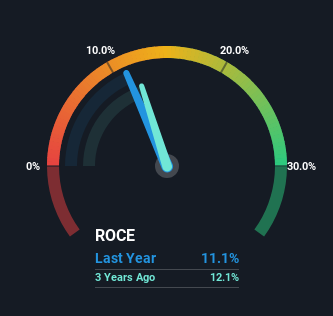Please use a PC Browser to access Register-Tadawul
Hasbro (NASDAQ:HAS) Could Be Struggling To Allocate Capital
Hasbro, Inc. HAS | 81.55 | -2.87% |
Finding a business that has the potential to grow substantially is not easy, but it is possible if we look at a few key financial metrics. In a perfect world, we'd like to see a company investing more capital into its business and ideally the returns earned from that capital are also increasing. Basically this means that a company has profitable initiatives that it can continue to reinvest in, which is a trait of a compounding machine. However, after briefly looking over the numbers, we don't think Hasbro (NASDAQ:HAS) has the makings of a multi-bagger going forward, but let's have a look at why that may be.
Understanding Return On Capital Employed (ROCE)
For those that aren't sure what ROCE is, it measures the amount of pre-tax profits a company can generate from the capital employed in its business. To calculate this metric for Hasbro, this is the formula:
Return on Capital Employed = Earnings Before Interest and Tax (EBIT) ÷ (Total Assets - Current Liabilities)
0.11 = US$573m ÷ (US$7.2b - US$2.1b) (Based on the trailing twelve months to September 2024).
Thus, Hasbro has an ROCE of 11%. That's a relatively normal return on capital, and it's around the 9.9% generated by the Leisure industry.

Above you can see how the current ROCE for Hasbro compares to its prior returns on capital, but there's only so much you can tell from the past. If you'd like, you can check out the forecasts from the analysts covering Hasbro for free.
How Are Returns Trending?
On the surface, the trend of ROCE at Hasbro doesn't inspire confidence. Over the last five years, returns on capital have decreased to 11% from 17% five years ago. Given the business is employing more capital while revenue has slipped, this is a bit concerning. If this were to continue, you might be looking at a company that is trying to reinvest for growth but is actually losing market share since sales haven't increased.
What We Can Learn From Hasbro's ROCE
In summary, we're somewhat concerned by Hasbro's diminishing returns on increasing amounts of capital. Investors haven't taken kindly to these developments, since the stock has declined 18% from where it was five years ago. With underlying trends that aren't great in these areas, we'd consider looking elsewhere.
Like most companies, Hasbro does come with some risks, and we've found 2 warning signs that you should be aware of.
This article by Simply Wall St is general in nature. We provide commentary based on historical data and analyst forecasts only using an unbiased methodology and our articles are not intended to be financial advice. It does not constitute a recommendation to buy or sell any stock, and does not take account of your objectives, or your financial situation. We aim to bring you long-term focused analysis driven by fundamental data. Note that our analysis may not factor in the latest price-sensitive company announcements or qualitative material. Simply Wall St has no position in any stocks mentioned.



